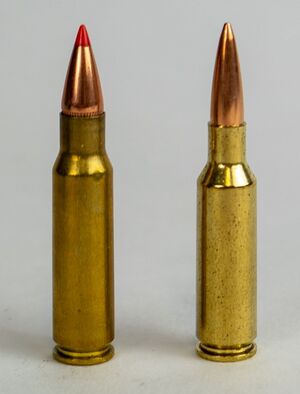5.7mm Quinn: Difference between revisions
m (1 revision imported) |
mNo edit summary |
||
| Line 3: | Line 3: | ||
{{Infobox firearm cartridge | {{Infobox firearm cartridge | ||
| name = 5.7mm x40 Quinn | | name = 5.7mm x40 Quinn | ||
| image = | | image = [[File:7mm_and_5-7mm_Quinn_Compared.jpg|300px|7mm Quinn (left), .5.7 Quinn (right)]] | ||
| caption = 7mm Quinn (left), .5.7 Quinn (right) | | caption = 7mm Quinn (left), .5.7 Quinn (right) | ||
<!-- Production info --> | <!-- Production info --> | ||
Revision as of 23:02, 9 July 2019
This article is incomplete because it is pending further input from participants, or it is a work-in-progress by one author. Please comment on this article's talk page to share your input, comments and questions. Note: To contribute to this article, you may need to seek help from the author(s) of this page. |
| 5.7mm x40 Quinn | ||||||||||||||||
|---|---|---|---|---|---|---|---|---|---|---|---|---|---|---|---|---|
 7mm Quinn (left), .5.7 Quinn (right) | ||||||||||||||||
| Place of origin | Tír Glas | |||||||||||||||
| Service history | ||||||||||||||||
| In service | 1980 onwards | |||||||||||||||
| Production history | ||||||||||||||||
| Designer | Quinn Arms | |||||||||||||||
| Designed | 1969-77 | |||||||||||||||
| Specifications | ||||||||||||||||
| Parent case | .30 Remington | |||||||||||||||
| Case type | Rimless, tapered bottleneck | |||||||||||||||
| Bullet diameter | 0.224 in (5.7 mm) | |||||||||||||||
| Neck diameter | 0.256 in (6.5 mm) | |||||||||||||||
| Shoulder diameter | 0.402 in (10.2 mm) | |||||||||||||||
| Base diameter | 0.421 in (10.7 mm) | |||||||||||||||
| Rim diameter | 0.422 in (10.7 mm) | |||||||||||||||
| Rim thickness | 0.049 in (1.2 mm) | |||||||||||||||
| Case length | 1.600 in (40.6 mm) | |||||||||||||||
| Overall length | 2.260 in (57.4 mm) | |||||||||||||||
| Rifling twist | 190mm or 165mm | |||||||||||||||
| Primer type | Small rifle | |||||||||||||||
| Maximum pressure | 55,000 psi (380 MPa) | |||||||||||||||
| Ballistic performance | ||||||||||||||||
| ||||||||||||||||
| Test barrel length: 410 millimetres (16 in) | ||||||||||||||||
The 5.7mm Quinn is a rimless bottlenecked intermediate cartridge developed in the 1970s in Tír Glas by Quinn Arms. The round was standardised between members the Triple Entente in 1980 and then the Vinyan Defence Community in 1990. The 5.7mm Quinn is derived from the .30 Remington cartridge.
Initial Development
The 5.7mm Quinn cartridge was designed to address the deficiencies of the 5.56mm x45 cartridge being touted by the Columbian armed forces as a new standard for the Global Alliance. Due to the terrain in which Glasic forces were expected to fight Tír Glas was reluctant to move to the 5.56mm cartridge but at the same time wished to move away from the currently issued 7mm x48. The resulting cartridge was the result of a study into the alternatives. A major point in the study was to offer superior downrange lethality and longer range than the 5.56 cartridge Columbia favoured in its M16 pattern rifles with a minimal loss in magazine capacity and a negligible increase in recoil. To this end the cartridge would bridge the gap between the SCHV 5.56 mm and larger 7mm cartridge already in service.
During testing it was determined that a 7mm bullet although offering better terminal ballistics than the SCHV 5.56mm would not possess the performance at range required to replace the 7mm x48. Further experiments were conducted with 6mm, 6.5mm and 5.7mm bullets, the end result was that the 5.7mm bullet was selected for further development of the cartridge whilst the 7mm would go on to become the 7mm Quinn. It was decided to expedite development to base the cartridge case off that of the .30 Remington, necked down to .224in (5.7mm), this resulted in increased case capacity compared to the 5.56mm x45 which in turn allowed for higher velocities to be obtained as well as seating longer, heaver, more aerodynamic bullets than the Columbian cartridge. It also maximised commonality between weapons chambered in 5.56mm x45, the Glasic cartridge only requiring a replacement barrel, bolt and possibly magazine.